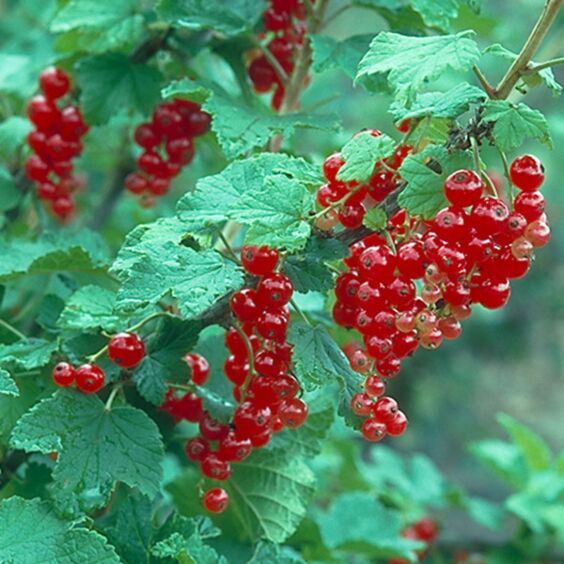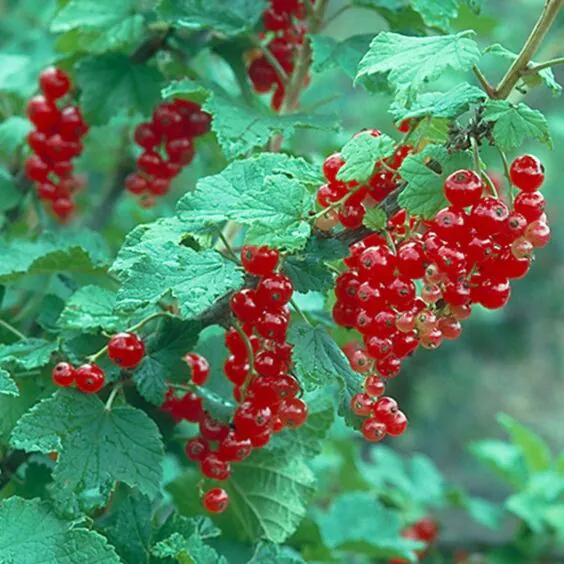

Growing zones
See Zone Map >Status: In stock
Aside from its delicious culinary applications, Red Lake Currant is also an excellent ornamental addition to cottage gardens. The shrub grows to be about 3-4 feet tall and 3-4 feet wide, making it a perfect choice for border plantings or as a focal point in your garden.
Red Lake Currant is easy to grow, requiring only moderate watering and pruning. With its high yield and extended bearing period, you'll have plenty of berries to go around. Plus, its tart flavor and bright red color make it a standout ingredient in any recipe.
Order your Red Lake Currant shrub today and experience the joy of home-grown, deliciously tangy currants that you can use in a wide range of sweet and savory dishes!
- Sun, Part Sun/Shade
Mature Plant Size (H x W): 3-4' x 3-4'
Bloom Season: Summer
- Attracts Bees
- Attracts Birds
- Walnut Toxicity Resistant
- Edible to People
- Attracts Butterflies
- Attracts Pollinators
Planting & Care for Edible Plants – Red Lake Currant
Preparation
- Pick a site with partial shade to full sun for this red currant.
- Because plants bloom very early in spring, they are susceptible to late season freezes. Choose a site that warms up slowly in the spring, to make sure it won’t cause any growing problems.
- Add in some compost to your soil before planting.
- Space the plants 3-6 feet apart in rows that are 6-8 feet apart.
- Be sure to test your soil before planting. If you’re not sure how to do this contact your local UW extension office for help on testing your soil. Gooseberry plants prefer a soil pH of 6.0-6.8. Steer clear of soils that are extremely heavy or poorly drained.
Opening Plant Material
- Bare Root - Cut open the bundle (top and roots are tied) and separate all the plants. Soak roots in buckets of water until planted. Each plant type will be labeled separately for identification. Do not expose the roots to sun. They should never dry out. Keep roots covered. All bare-root plants must be trimmed when planted.
Planting Bare Root
- Dig a hole at least 6" wider and the same depth as the root mass. The crown or graft of the plant should be slightly higher than ground level where it was grown at the nursery.
- Trim off the broken roots and branches.
- Place fertilizer packets in hole (if purchased). Do not place other fertilizers in the planting hole. *Use Our Recommended Fertilizer
- Spread the roots and fill halfway with soil, then water until soil settles completely saturating the soil and planting pit.
- Re-adjust plant and fill the hole with the rest of the soil.
- Back-fill the balance of the soil and water well.
Pruning – After Planting
- Prune ALL bare root plants to reduce transplant shock and ensure success. Pruning should occur either before or as soon after planting as possible. All pruning should be done with a sharp pruning shears.
Pruning - Through-out the Season
- Each spring, make sure to prune away weak and any branches that are overcrowding. Only leave several shoots from each year’s growth.
- Prune off all 3-year-old branches to make room for more fruitful, younger branches.
- Gooseberries produce best on 1-year wood. Branches that produced the preceding year should be removed.
Watering - After Planting
- Plants typically take approximately 6 weeks to establish new roots in your soil. During this period, water plants as often as every 2-4 days at the start and at least a minimum of once per week.
- Beyond the 6 week establishment period, water once per week, unless rains occur.
- Stick your finger into the soil around 3” to check soil moisture.
Watering - Through-out the Season
- After the first season, plants should only be watered during extended periods without rain.
- How do you know if your plants need water? The easiest way to tell is to touch the soil around the roots. If it is moist, there is no need to water. If it is dry, give it a good soaking with the hose end (no nozzle) watering the soil only, not the leaves.
- Stick your finger into the soil around 3” to check soil moisture.
Planting & Handling Help
Download our Planting and Handling Guide below to plan for a successful arrival and install of your plants. Be sure to water all plants as soon as they arrive and every day until you’re ready to plant. Keep any bare root bundles in a shady, cool spot with the roots covered at all times.


Learn More
Watch our videos on handling bare root plants, how your order is prepared for shipment and more.


Plant Sizing
What is the difference between Containers, Grow Bags, Bare Root, and Balled & Burlap (B&B)?
Shipping Times


Our FedEx and local shipping times depend on two factors, one is by the region and the second is the type of product being shipped. For example, small fruits are only shipped in spring, but majority of our perennials are shipped from spring until fall. Keep in mind the dates below act as a general guide. Due to unpredictable weather, staffing, inventory and industry demands these timelines can change. Therefore, we cannot guarantee any of these times.
Shipping Dates by Region*
Northern Cold Region: April 22nd - November 7th
Northern Region: April 15th - November 7th
Middle Region: April 1st - November 7th
Southern Region: March 15th - November 7th
Local Delivery (small radius from Waterloo, WI): April 22nd - November 7th
Shipping Dates by Season*
Spring Shipping: Region Start Date (above) - May
Fall Shipping: September - November
Due to unpredictable weather, these times may vary. Some varieties are exceptions due to heat and plant health reasons. Enter your shipping zip code at the top of this page and be sure to check the shipping information on each product before you add it to your cart. If the product is too large or restricted in your state, you will not be able to checkout with that item in your cart.

